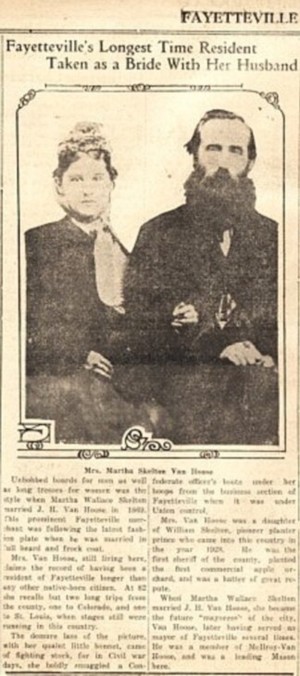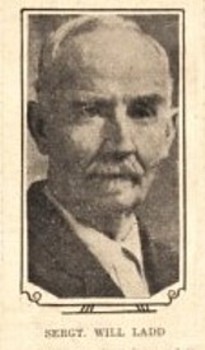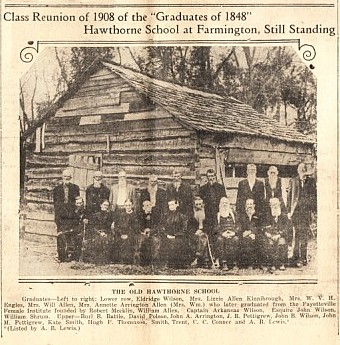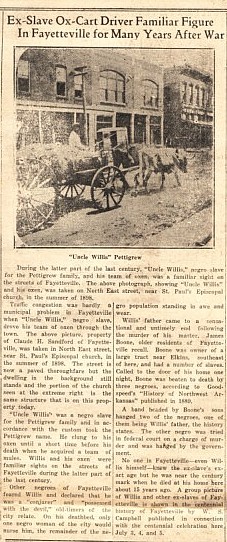M. BAUM MERCHANT OF CITY FOR OVER HALF CENTURY
____________
By SARAH TATUM
Back in the late '70's, the advent of auto-mobiles and paved streets in Fayetteville, the city claimed the largest general mercantile store in the county and one of the best known business establishments in the state. This place which stood on the east side of the square belonged to two brothers, Lee and Mose Baum, the latter being Fayetteville's oldest living merchant and one in business here for over half a century.
On Saturdays when the people from the outlying districts came to town to do their week's shopping it was invariably to Baum's store that they turned their vehicles and it was well understood that Baum's set the style in ladies' dress.
This store had a milliner come all the way from St. Louis, Missouri, to bring the latest thing in hats and they were the proud possessors of one of the first messanine floors in the country. It was six feet square but nevertheless it was a messanine floor.
Lee and Mose, the owners of the store, acted in the official capacity of floor walkers and greeted their customers with the congenial manner of old friends. Their first business was next door to what is now the Mountain Inn. After a fire which destroyed their entire stock they moved to their new location and soon had the largest and most popular store in the county.
_____________
Mrs. Margaret B. Taylor Oldest Native-Born, Has Interesting History
Margaret Blakemore Taylor (Mrs. Isaac Taylor), daughter of Lee Taylor Blakemore and of Sallie Byrnside Blakemore, who was 93 last Wednesday and who observed her birthday with a Centennial Week family reunion at her home on College Avenue Sunday, is Fayetteville's oldest native-born white citizen, so far as is known.
Born in a log cabin June 27, 1835, while Arkansas still was a territory, Mrs. Taylor spent her entire life here except 11 years during which she resided in Tennessee and she has witnessed not only the forming of the state but the progress of Fayetteville during the past three-quarters of a century.
Her grandfather, James Byrnside, came here by ox-wagon in 1830 with his family from Batesville after having left Virginia and trecked to St. Louis and down the Mississippi river. Her mother, Sallie Byrnside, was 15 years old. Her father, Lee Taylor Blakemore, a surveyor and a relative of the Byrnside family, came here from Tennessee in 1831, carrying the chain that was later used in surveying the town.
Picture of Early Fayetteville
Mrs. Taylor's remembrance of Fayetteville in her early childhood was a village of a few log houses, widely separated, a school, her grandfather's tavern, and one store and bakeshop. What is now College Avenue was a muddy, or dusty, road according to weather and was then called "The Missouri Road," a part of the Butterfield Trail which turned at Maple and on out of town by way of the Gunter place, later birthplace of Governor Gunter of Colorado.
Her grandfather's first residence stood where the Cravens'-King buildings now stand. The front yard was filled with flowers snowball, bleeding heart and roses.
"Paper money?" she states. "I never saw any until the Civil War. Bits (12 1-2 cent pieces) and picayunes were our silver coins."
Attended First School; Also Sawyer Seminary
At six years Mrs. Taylor accompanied by a negro slave was carried in a straight back chair to school in a large brick building located in the same block where the high school now stands. The chair, won smooth, sits still in the corner of Mrs. Taylor's bedroom.
At nine years she attended the Female Seminary under direction of Miss Sawyer of Massachusetts, whose story and picture appears elsewhere in this paper. The Semi-nary was a boarding school and college where primary students were taught reading, writing, arithmetic and geography, also sewing and dancing. She remained here three years.
At the age of 12 Mrs. Taylor moved to Tennessee where with one visit "home" she lived until 1859 when she and her husband returned to spend the rest of their lives. The family came by water down the Mississippi, up the Arkansas to Van Buren and overland by wagon to Fayetteville.
Lovely old silver, linen, candle holders, a marble clock, gilt mirrors, sewing table, four poster bed, lend charm to the home of this woman, the city's oldest native-born, a true Southern aristocrat with sweet face and lovable personality.

Mrs. Martha Skelton Van Hoose
Unbobbed beards for men as well as long tresses for women was the style when Martha Wallace Skelton married J. H. Van Hoose in 1869.This prominent Fayetteville merchant was following the latest fashion plate when he was married in full beard and frock coat. Mrs. Van Hoose, still living here, claims the record of having been a resident of Fayetteville longer than any other native-born citizen. At 82 she recalls but two long trips from the county, one to Colorado and one to St. Louis, when stages still were running in this country. The demure lass of the picture, with her quaint little bonnet, came of fighting stock, for in Civil war days, she boldly smuggled a Confederate officer's boots under her hoops from the business section of Fayetteville when it was under Union control. Mrs. Van Hoose was a daughter of William Skelton, pioneer planter prince who came into this country in the year 1928. He was the first sheriff of the county, planted the first commercial apple orchard and was a hatter of great repute. When Martha Wallace Skelton married J. H. Van Hoose, she became the future "mayoress" of the city, Van Hoose, later having served as mayor of Fayetteville several times. He was a member of McIlroy-Van Hoose and was a leading Mason here.
===============================
Fayetteville Battle
Has Six Survivors;
One Now Seriously Ill
By PEGGY SUE LIGHTON
On April 18, 1863, Fayetteville was the scene of a bloody battle and Confederate General Cabell was repulsed in his attempt to drive the Federals out of town.
The fight lasted three hours and much of it was bitter hand-to-hand struggle. Where it was fought is now the intersection of two of

Sergt. Will Ladd
the main streets of Fayetteville-College Avenue and Dickson street. The spot is to be one of the six historic sites which will be designated by a bronze marker to be placed July 5, the final day of the Centennial.
Of the hundreds who took part in the battle, only six are known to be living. Five are Federal veterans, all living here in Fayetteville, and, strangely enough, four of the same company-Co. C. of the First Arkansas Cavalry. These four are: Capt. E. B. Harrison, now 88; Lieut. Phillip Maguire, 84; Sergt. Will Ladd, 84; Corp. Noah Johnson, 87. Johnson, during part of the war, acted as commissary sergeant for the regiment, but never was commissioned to that rank, he says. S. H. Blackmer, Co. A. Inf., also survives.
Capt. Marion Anderson of Crosses, a small town 30 miles east of Fayetteville, is the sole Confederate survivor of the battle.
===============================
9 STATE-CHARTERED COLLEGES IN COUNTY BEFORE CIVIL WAR
1836-Fayetteville Female Academy chartered October 27, 1836, (Site on School street, exact spot unknown. 1843-Far West Academy, Mount Comfort, incorporated in 1844. 1850-Cane Hill Collergia telitsntuet 1850-Cane Hill Collegiate Institute, incorporated December 26, 1850 1852-Cane Hill Female Seminary, incorporated Dec. 10, 1852. 1852-Arkansas College, Fayetteville chartered December 14, 1852. 1852-Cane Hill College, incorporated December 15, 1852. 1858-Fayetteville Female Institute, Fayetteville, incorporated Dec. 16, 1858. 1859-Fayetteville Female Seminary, incorporated January 21, 1859.
OX-CART TO PLANE HISTORY OF CITY'S MODES OF TRAVEL
______________
From covered wagon and ox-cart to train, and from automobile to airplane has been the evolution of the modes of travel in and out of Fayetteville during the past 100 years.
The trail that first was beaten in the wilderness by horses' feet of Indian savage and early white settler, then widened to accommodate the coach-and-six, has now become made into a highway that soon will be hard-surfaced and extend through Fayetteville from Canada to the Gulf. In being of concrete and macadam for cars it also becomes a silver path for fliers who for air mail service or merely individual travel, will be guided by the road or by the parallel shining steel rails to their destination.
Fayetteville in her 101st year is looking toward establishing an air port, making ready for her airplane travel. Several years ago she established her tourist camp, making ready for automobile tourists. A step toward her "air-mindedness" is the marking of the city, "Fayetteville" in 10-foot white letters on the Engineering building of the University, that no birdman, flying over, may fail to realize that he is in the Athens of the Ozarks, the home of the State University, and that an airport awaits his landing, if perchance, he wishes to stop here.
______________
Hawthorne School Earliest in Area: Is Still Standing
A pioneer school in this county with history said by educators to have no equal is still standing and has been scene of pilgrimages by descendents of its first students during Fayetteville's Centennial Week. It was built in 1842 by Joseph Lewis, father of A. B. Lewis, grandson of John Lewis who came to this country from Ireland.
"The Hawthorne School," it was called by its founders, 15 early families, six of whom were slave holders, 12 of whom were from Tennessee, one from Georgia, one from Alabama and one from Virginia, who, finding themselves in a wilderness without educational advantages for their children, built it themselves and manned it with the best teachers they could get.
According to a letter written by A. B. (Uncle Gus) Lewis, in 1858, 18 of its 27 graduates of the class of 1848 were living within 10 miles of the building and these gathered for a reunion as shown in the accompanying picture.
Mr. Lewis, of Fayetteville, a member of the class and shown standing on the extreme right, passed away at the age of 98, January 29 of this year.
Confederate colonels, captains and sergeants were listed among its students, not one of whom ever was tried in any court for any violation of law and every one of whom achieved more or less distinction.
The school district furnished the sheriff of the county for 30 years, the county clerk for 40 years. One student was assessor four year. Another was four years treasurer

THE OLD HAWTHORNE SCHOOL
Graduates--Left to right:
Lower row, Eldridge Wilson, Mrs. Lizzie Allen Kinnibrough, Mrs. W. V. H. Engles, Mrs. Will Allen, Mrs. Annette Arrington Allen (Mrs. Wm.) who later graduated from the Fayetteville Female Institute founded by Robert Mccklin, William Allen, Captain Arkansas Wilson, Esquire John Wilson, William Shrum.
Upper--Burl B. Battle, David Polson, John A. Arrington, J. R. Pettigrew, John B. Wilson, John M. Pettigrew, Kate Smith, Hugh F. Thomason, Smith, Trent, C. C. Conner and A. B. Lewis*
*(Listed by A. B. Lewis)
===========================
Battle of Fayetteville Survivor to Tell Story, Recall Earliest History
By Courtney Walker
When Captain E. B. Harrison, federal officer under General Herron in December, 1862, advanced on the little village of Fayetteville and with other Federals occupied the town, he little realized that he would later return and make it his home, becoming on of Fayetteville's oldest and most respected

CAPT. E. B. HARRISON
citizens. On July 5th Captain Harrison, as one of four survivors of the battle of Fayetteville and one of its two Federal surviving officers, will tell of this battle at the unveiling of the marker of the Battle Site.
At the close of the war Captain Harrison went to his home in Michigan but shortly returned to Fayetteville where he has resided ever since.
In 1867 he was appointed U. S. commissioner for the western district and served in that capacity for over 25 years.

"Uncle Willis" Pettigrew
During the latter part of the last century, "Uncle Willis," negro slave for the Pettigrew family, and his team of oxen, was a familiar sight on the streets of Fayetteville.
Traffic congestion was hardly a municipal problem in Fayetteville when "Uncle Willis" drove his team of oxen through the town. The above picture, property of Claude H. Sandford of Fayetteville, was taken in North East street, near St. Paul's Episcopal church, in the summer of 1898. The street is now a paved thoroughfare but the dwelling in the background still stands and the portion of the church seen at the extreme right is the same structure that is on this property today.
"Uncle Willis" was a negro slave fro the Pettigrew family and in accordance with the custom took the Pettigrew name. He clung to his oxen until a short time before his death when he acquired a team of mules. Willis and his oxen were familiar sights on the streets of Fayetteville during the latter part of the last century.
Other negroes of Fayetteville feared Willis and declared that he was a "conjurer" and "possessed with the devil," old-timers of the city relate. On his deathbed, only one negro woman of the city would nurse him, the remainder of the negro population standing in awe and wear.
Willis' father came to a sensational and untimely end following the murder of his master, James Boone, older residents of Fayetteville recall. Boone was owner of a large tract near Elkins, southeast of here, and ha a number of slaves. Called to the door of his home one night, Boone was beaten to death by three negroes, according to Goodspeed's "History of Northwest Arkansas" published in 1889.
A band headed by Boone's sons hanged two of the negroes, on of them being Willis' father, the history states. The other negro was tried in federal court on a charge of murder and was hanged by the government.
No one in Fayetteville-even Willis himself-knew the ex-slave's exact age but he was near the century mark when he died at his home here about 15 years ago. A group picture of Willis and other ex-slaves of Fayetteville is shown in the centennial history of Fayetteville by W. S. Campbell published in connection with the centennial celebration here July 3, 4, and 5.
=========================
OCTAVE THANET, ARKANSAN, AND SOME OF HER VOLUMES
Octave Thanet (Alice French) for 30 years lived in Arkansas. Many of her stories have to do with this section of the Ozarks. She was a visitor here but her name was in Clover Bend Plantation in Crawford, Lawrence county. Some of her books with Arkansas "local color" are: Knitters in the Sun, Otto the Knight, Stories of a Western Town, Adventures in Photography, Missionary Sheriff, A Book of True Lovers, Heart of Toil, A slave to Duty, Man of the Hour, the Lion's Share, By Inheritance, Stories that End Well, A Step on the Stair, The Captain Answered.
=========================
At that time the United States court, located at Fort Smith under the jurisdiction of Judge Parker, was the only Indian court west of the Mississippi, and had control of an area reaching as far west as the Rocky Mountains. As the only other commissioner in the district, Captain Harrison in his court of preliminary trial served a vast number of Indians, chiefly from the northwest and composed of the member of the Five Nations.
Writs for arrest had to be obtained from Captain Harrison by U. S. and deputy U. S. marshals who brought the offenders before him for preliminary investigation and if a reasonable doubt existed as to their guilt, they were bound over for trial before Judge Parker at Fort Smith.
Preliminary trials, he recalls, were held at night, usually in the old frame court house located on the site of the present post office, for Captain Harrison operated a hardware store during daytime.
Often, he states, as many as 20 or more Indian prisoners were brought into Fayetteville at one time and their encampments in the valley south of the city made a colorful pageant. Due to the large number of offenders, no regular term of court was held and trials were in operation the year round.